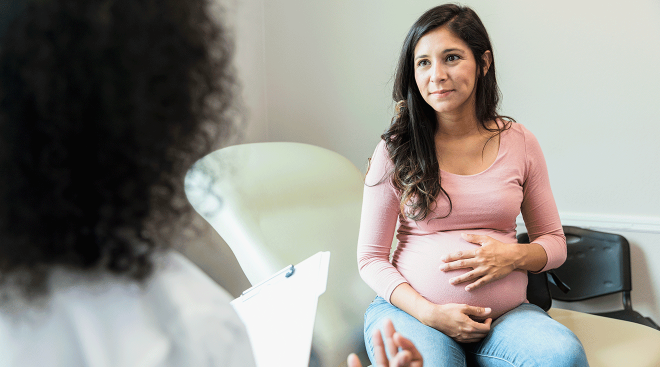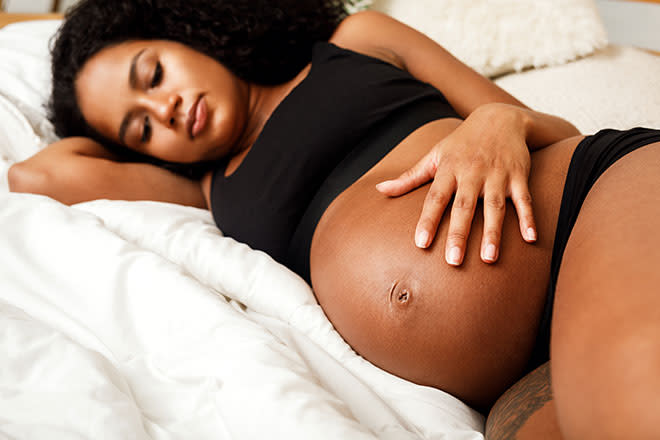What It Means to Have an Anterior Placenta
It’s only natural to be concerned about every aspect of your pregnancy. After all, your top priority is to ensure the health of that sweet little one growing inside you. So if you’ve been told you have an anterior placenta, you’re likely wondering what that means and whether it can pose a threat to baby. Fortunately, you can rest assured that this scientific-sounding term simply means your placenta is positioned in front of baby. In general, it’s nothing to worry about. Still, it’s a good idea to educate yourself about the changes happening in your body. Ready to learn more about how an anterior placenta affects pregnancy and delivery? Here’s what you need to know.
The placenta is an organ that develops in pregnancy. Along with the umbilical cord, it supplies oxygen, nutrients and hormones to baby, and helps remove waste. As baby grows during those first weeks of gestation, so will the placenta. It can develop anywhere along the uterus and may even move positions throughout pregnancy. When the placenta is located on the front side of the uterus, it’s referred to as an “anterior placenta.” This is completely normal, says Eric Strand, MD, an ob-gyn and associate professor at Washington University. “The placenta will typically grow either along the front (anterior) wall, back (posterior) wall, or top (fundal) of the uterus.”
How common is anterior placenta?
All of the previously mentioned placental positions are considered normal and safe. Still, if your placenta has been located in front of baby, you might be wondering: “How common is anterior placenta?” It’s estimated that 33 to 50 percent of pregnancies have an anterior placenta. The placenta can migrate, though, and this position is slightly less typical toward the end of pregnancy.
Anterior vs. posterior placenta
If you have an anterior placenta, the organ has developed on the front wall of the uterus closest to your stomach. On the other hand, a posterior placenta means that it’s growing on the wall of the uterus closest to your spine.
You may hear your OB mention a few other keywords in regards to your placental position: “Fundal” means toward the top of your uterus, and “lateral” means on a side. Most doctors will tell you that none of these positions are cause for concern. However, if they mention that you have a low-lying placenta or placenta previa, it may be a red flag (more on this later).
How is anterior placenta diagnosed?
Wondering how you’ll know if you have an anterior placenta? Ultrasound is the best way to diagnose the condition. At your mid-pregnancy ultrasound, your doctor or ultrasound tech will be able to see your placenta’s position, and may tell you that it’s growing in front of baby.
Having an anterior placenta is generally considered harmless, but if you’ve been pregnant before with a different placental position, there are some things that may seem slightly different this time around.
Many women wonder if this uterine position will affect how their baby bump looks—but no, there’s no specific anterior placenta belly shape, says Heather Bartos, MD, an ob-gyn and the medical director of Be. Women’s Health and Wellness in Frisco, Texas. You can’t identify an anterior placenta just by looking at a pregnant belly. (To confirm an anterior placenta, ultrasound is needed.) It’s true there’s an extra layer of cushioning when the placenta is located toward the front of the body, but it doesn’t increase the size of your bump.
So how does an anterior placenta actually impact pregnancy? Below, some things to keep in mind, plus a few minor anterior placenta risks to be aware of.
Feeling fetal movement
There’s nothing more exciting than feeling those first tiny kicks. But if you have an anterior placenta, you may have to wait a bit longer for this important milestone. What does baby movement feel like with anterior placenta? “It can be more difficult for a mother to initially feel the baby move with an anterior placenta,” says Strand. “Essentially, it’s an extra layer of cushioning between the baby and the mother.”
While most moms-to-be may start feeling baby kick between 18 and 20 weeks, you may not notice it until closer to 20 to 22 weeks, especially if you’re not familiar with the way those early flutters feel. Bartos says that an anterior placenta essentially has a muffling effect. She had an anterior placenta in her own pregnancies, and says that the position made it more difficult for her partner to feel kicks or movement from the outside too.
Still, if you’re having trouble detecting movement and feeling concerned, trust your gut and give your doctor a call. There’s no harm in getting checked.
Detecting fetal heartbeat
Typically at every visit from 10 weeks and beyond, your doctor will assess baby’s heart rate via fetal doppler or ultrasound. As the weeks pass, it’ll get easier for your doctor to find the heartbeat. But if you have an anterior placenta, you may hear more of a muffled “whooshing” sound, says Bartos.
Getting diagnostic tests
Amniocentesis is a procedure that’s performed to detect abnormalities in the fetus. However, it may be a bit more difficult for your doctor to perform this test if your placenta is anterior; that’s because the needle used to draw amniotic fluid out of the gestational sac will need to work around the placenta. Fortunately, with today’s advanced ultrasound equipment, this is considered little more than a slight inconvenience.
Anterior placenta previa
Your doctor won’t be fazed by the anterior or posterior position of your placenta. However, they may be alerted if your placenta is in a low-lying position. This is known as placenta previa, a relatively rare condition that affects about 1 in 200 pregnancies.
Anterior placenta previa means that the placenta is positioned in front of the uterus but also covering all or part of the cervix. (It’s important to note that placenta previa can occur with a posterior placenta as well; it has nothing to do with the fact that your placenta is anterior.)
If you’re told you have anterior placenta previa, your doctor will likely take a “wait and watch” approach, since the condition often corrects itself as pregnancy progresses. “Throughout pregnancy, the placenta typically migrates away from the cervix—so while a low-lying placenta is pretty common at the time of the anatomy scan (5 to 10 percent of the time), it resolves itself about 95 percent of the time,” says Strand.
If it remains staunchly low as the weeks go by and your due date approaches, your doctor will likely discuss the potential need for a scheduled c-section to ensure your health and safety—and that of baby. Vaginal delivery with placenta previa can be dangerous and lead to hemorrhaging.
When it finally comes time to meet baby, your anterior placenta most likely won’t affect much on the big day. Strand says, “We do not currently think that an anterior placenta has any negative impact on pregnancy outcomes or route of delivery.”
Still, one small study indicated that an anterior placenta may increase the need for an induction, c-section or manual placenta removal. It’s worth noting that the researchers couldn’t find any clear reason for this correlation though, so more follow up is needed.
“I think the biggest risk of anterior placenta is that the mom gets used to not feeling the baby move as much, so if there’s an issue with the baby, she may not be able to tell as readily,” Bartos says. Despite this, anterior placenta moms don’t get nonstress tests or further testing, she adds.
As for other potential risks, a 2013 study indicated a slightly higher incidence of certain pregnancy complications, including:
- Pregnancy-induced hypertension
- Gestational diabetes
- Placental abruption
- Intrauterine growth restriction
While these supposed anterior placenta risks and complications may sound alarming, it’s important to realize that this research looked at just about 500 cases, and many more moms with anterior placentas have had healthy pregnancies and deliveries. “Nearly one third of all women have an anterior placenta, so if there were major issues or risks, they would be very obvious by now,” Bartos says. The reassuring truth is that having an anterior placenta is considered fairly benign.
Now that you understand more about the position of your placenta, you can relax and focus on keeping yourself and baby healthy during your pregnancy. Most doctors would confidently tell you that anterior placenta risks are low. You may just have to wait a bit longer to feel those precious kicks and elbow jabs! Of course, if you have any concerns, talk to your doctor.
About the experts:
Heather Bartos, MD, is an ob-gyn and the medical director of Be. Women’s Health and Wellness in Frisco, Texas. A navy veteran, she spent 12 years serving the women and spouses of the armed forces in Washington, D.C… She earned her medical degree at The University of Texas at Houston.
Eric Strand, MD, is an ob-gyn and associate professor at Washington University. He received his medical degree at Johns Hopkins School of Medicine in Baltimore, Maryland.
Please note: The Bump and the materials and information it contains are not intended to, and do not constitute, medical or other health advice or diagnosis and should not be used as such. You should always consult with a qualified physician or health professional about your specific circumstances.
Plus, more from The Bump:
Navigate forward to interact with the calendar and select a date. Press the question mark key to get the keyboard shortcuts for changing dates.




















































